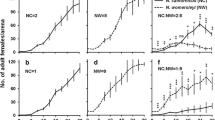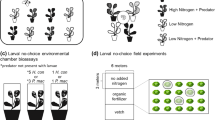Abstract
Predator non-consumptive effects (NCEs) have been well studied in many ecosystems and NCEs can alter the behavior, morphology and life history of prey, producing strong trait-mediated indirect effects (TMIEs) on host plants. However, studies involving the application of NCEs to control pests in the field, and instances of combined laboratory bioassay and field practice are rare. Here, we examine the development, reproduction and behavior of small brown planthoppers, Laodelphax striatellus (Fallén), when exposed to predator cues from caged predators (Paederus fuscipes Curtis), or predator body extracts (in solvents with different polarities) in the laboratory. Field foliage sprays of these extracts were also used to test their effects on the L. striatellus population and rice plant biomass. Nymph development and egg hatch rate in L. striatellus were not influenced, but adult longevity was shorter, and fecundity and weight gain were lower, when nymphs were exposed to the predator cues. Adults exposed to predator cues also gained less weight and laid fewer eggs. The poorer developmental and reproductive performances might result from lower activity levels observed in threatened L. striatellus. The field foliage sprays of predator cues decreased L. striatellus abundance and increased rice plant biomass, suggesting their possible application for pest control. Predator cues extracted using chloroform increased stronger NCEs and TMIEs, indicating their non-polar characteristics. Our studies advance the understanding of how NCEs shape the life history and behavior of L. striatellus and improve rice growth, laying new foundations for future research on novel pest control materials and methods.



Similar content being viewed by others
Data availability
All data available from the figshare. Dataset (https://doi.org/10.6084/m9.figshare.14178341.v1).
Code availability
All the data analysis were conducted in R version 4.0.3.
References
Aflitto NC, Thaler JS (2020) Predator pheromone elicits a temporally dependent non-consumptive effect in prey. Ecol Entomol 45:1190–1199
Beauchamp G, Ruxton GD (2011) A reassessment of the predation risk allocation hypothesis: a comment on Lima and Bednekoff. Am Nat 177:143–146
Beckerman AP, Uriarte M, Schmitzet OJ (1997) Experimental evidence for a behavior mediated trophic cascade in a terrestrial food chain. PNAS 94:10735–10738
Beleznai O, Tholt G, Tóth Z, Horváth V, Marczali Z, Samu F (2015) Cool headed individuals are better survivors: non-consumptive and consumptive effects of a generalist predator on a sap feeding insect. PLoS ONE 10(8):e0135954
Bestion E, Cucherousset J, Teyssier A, Cote J (2015) Non-consumptive effects of a top-predator decrease the strength of the trophic cascade in a four-level terrestrial food web. Oikos 124:1597–1603
Culshaw-Maurer M, Sih A, Rosenheim JA (2020) Bugs scaring bugs: enemy-risk effects in biological control systems. Ecol Lett 23:1693–1714
Dettner K, Liepert C (1994) Chemical mimicry and camouflage. Annu Rev Entomol 39:129–154
Dixon AFG, Agarwala BK (1999) Ladybird-induced life-history changes in aphids. Proc R Soc B 266:1549–1553
Duffy MA, Housley JM, Penczykowski RM, Caceres CE, Hall SR (2011) Unhealthy herds: indirect effects of predators enhance two drivers of disease spread. Funct Ecol 25:945–953
Elliott KH, Betini GS, Dworkin I, Norris DR (2015) Experimental evidence for within- and cross-seasonal effects of fear on survival and reproduction. J Anim Ecol 85:507–515
Fischer S, Pereyra D, Fernández L (2012) Predation ability and non-consumptive effects of Notonecta sellata (Heteroptera: Notonectidae) on immature stages of Culex pipiens (Diptera: Culicidae). J Vector Ecol 37:245–251
Freitas AVL, Oliveira PS (1996) Ants as selective agents on herbivore biology: effects on the behaviour of a non-myrmecophilous butterfly. J Anim Ecol 65:205–210
Graeve A, Janßen M, Villalba de la Pena M, Tollrian R, Weiss LC (2021) Higher, faster, better: maternal effects shorten time lags and increase morphological defenses in Daphnia lumholtzi offspring generations. Front Ecol Evol 9:637421
Hemptinne JL, Lognay G, Doumbia M, Dixon AFG (2001) Chemical nature and persistence of the oviposition deterring pheromone in the tracks of the larvae of the two-spot ladybird, Adalia bipunctata (Coleoptera: Coccinellidae). Chemoecology 11:43–47
Hermann SL, Landis DA (2017) Scaling up our understanding of non-consumptive effects in insect systems. Curr Opin Insect Sci 20:54–60
Hermann SL, Thaler J (2014) Prey perception of predation risk: volatile chemical cues mediate non-consumptive effects of a predator on a herbivorous insect. Oecologia 176:669–676
Hoefler CD, Durso LC, McIntyre KD (2012) Chemical-mediated predator avoidance in the European house cricket (Acheta domesticus) is modulated by predator diet. Ethology 118:431–437
Kersch-Becker MF, Thaler JS (2015) Plant resistance reduces the strength of consumptive and non-consumptive effects of predators on aphids. J Anim Ecol 84:1222–1232
Khudr MS, Buzhdygan OY, Petermann JS, Wurst S (2017) Fear of predation alters clone specifc performance in phloem feeding prey. Sci Rep 7:7695
Kozlowski J (1992) Optimal allocation of resources to growth and reproduction: implications for age and size at maturity. Trends Ecol Evol 7:15–19
Laurent L, Braekman JC, Daloze D (2005) Insect chemical defense. Top Curr Chem 240:167–229
Lima SL, Dill LM (1990) Behavioral decisions made under the risk of predation: a review and prospectus. Can J Zool 68:619–640
Lo Pinto M, Cangelosi B, Colazza S (2013) Female-released sex pheromones mediating courtship behavior in Lysiphlebus testaceipes males. J Insect Sci 13:53
Ma CY, Gao CF, Wei HJ, Shen JL (2007) Resistance and susceptibility to several groups of insecticides in the small brown planthopper, Laodelphax striatellus (Homoptera: Delphacidae). Chin J Rice Sci 21:555–558
McPeek MA, Grace M, Richardson JML (2001) Physiological and behavioral responses to predators shape the growth/predation risk trade-off in damselflies. Ecology 82:1535–1545
Montserrat M, Bas C, Magalhães S, Sabelis MW, de Roos AM, Janssen A (2007) Predators induce egg retention in prey. Oecologia 150:699–705
Nakashima Y, Birkett MA, Pye BJ, Powell W (2006) Chemically mediated intraguild predator avoidance by aphid parasitoids: interspecific variability in sensitivity to semiochemical trails of ladybird predators. J Chem Ecol 32:1989–1998
Nelson EH (2007) Predator avoidance behavior in the pea aphid: costs, frequency, and population consequences. Oecologia 151:22–32
Ninkovic V, Feng Y, Olsson U, Pettersson J (2013) Ladybird footprints induce aphid avoidance behavior. Biol Control 65:63–71
Op de Beeck L, Janssens L, Stoks R (2016) Synthetic predator cues impair immune function and make the biological pesticide Bti more lethal for vector mosquitoes. Ecol Appl 26:355–366
Otuka A, Matsumura M, Sanada-Morimura S, Takeuchi H, Watanabe T, Ohtsu R, Inoue H (2008) The 2008 overseas mass migration of the small brown planthopper, Laodelphax striatellus, and subsequent outbreak of rice stripe disease in western Japan. Appl Entomol Zool 45:259–266
Otuka A, Zhou Y, Lee GS, Matsumura M, Zhu Y, Park HH, Liu Z, Sanada-Morimura S (2012) Prediction of overseas migration of the small brown planthopper, Laodelphax striatellus (Hemiptera: Delphacidae) in East Asia. Appl Entomol Zool 47:379–388
Peacor SD, Peckarsky BL, Vonesh TGC, JR, (2013) Costs of predator-induced phenotypic plasticity: a graphical model for predicting the contribution of nonconsumptive and consumptive effects of predators on prey. Oecologia 171:1–10
Peckarsky BL, Abrams PA, Bolnick DI, Dill LM, Grabowski JH, Luttbeg B, Orrock JL, Peacor SD, Preisser EL, Schmitz OJ, Trussell GC (2008) Revisiting the classics: considering nonconsumptive effects in textbook examples of predator-prey interactions. Ecology 89:2416–2425
Peschke K (1983) Defensive and pheromonal secretion of the tergal gland of Aleochara curtula II. Release and inhibition of male copulatory behavior. J Chem Ecol 9:13–31
Peschke K, Metzler M (1982) Defensive and pheromonal secretion of the tergal gland of Aleochara curtula: I. The Chemical Composition J Chem Ecol 8:773–783
Peschke K, Metzler M (1987) Cuticular hydrocarbons and female sex pheromones of the rove beetle, Aleochara curtula (Goeze) (Coleoptera:Staphylinidae). Insect Biochem 17:167–178
Post P, Götmark F (2006) Foraging behavior and predation risk in male and female Eurasian blackbirds (Turdus merula) during the breeding season. Auk 123:162–170
R Core Team (2020) R: A language and environment for statistical computing. R Foundation for Statistical Computing, Vienna. https://www.r-project.org/
Ramirez RA, Snyder WE (2009) Scared sick? Predator-pathogen facilitation enhances exploitation of a shared resource. Ecology 90:2832–2839
Rawlings TA (1994) Effect of elevated predation risk on the metabolic rate and spawning intensity of a rocky shore marine gastropod. J Exp Mar Bio Ecol 181:67–79
Schmitz OJ, Beckerman AP, O’Brien KM (1997) Behaviorally mediated trophic cascades: effects of predation risk on food web interactions. Ecology 78:1388–1399
Schmitz OJ, Krivan V, Ovadia O (2004) Trophic cascades: the primacy of trait-mediated indirect interactions. Ecol Lett 7:153–163
Sheriff MJ, Peacor SD, Hawlena D, Thaker M (2020) Non-consumptive predator effects on prey population size: A dearth of evidence. J Anim Ecol 86:1302–1316
Silberbush A, Markman S, Lewinsohn E, Bar E, Cohen JE, Blaustein L (2010) Predator-released hydrocarbons repel oviposition by a mosquito. Ecol Lett 13:1129–1138
Stökl J, Steiger S (2017) Evolutionary origin of insect pheromones. Curr Opin Insect Sci 24:36–42
Thaler JS, Griffin GAM (2008) Relative importance of consumptive and non-consumptive effects of predators on prey and plant damage: the influence of herbivore ontogeny. Entomol Exp Appl 128:34–40
van Driesche RG, Heinz KM (2004) An overview of the biological control in protected culture. In: Heinz KM, van Driesche RG, Parrella MP (eds) Biocontrol in protected culture. Ball publishing, Batavia, pp 7–24
Weiss LC, Tollrian R (2018) Predator induced defenses in crustacea. In: Welborn GA, Thiel M (eds) The natural history of Crustacea: life histories, vol 5. Oxford University Press, New York, pp 303–321
Weisser WW, Braendle C, Minoretti N (1999) Predator induced morphological shift in the pea aphid. Proc R Soc B 266:1175–2118
Wen J, Ueno T (2021) Predator cue-induced plasticity of morphology and behavior in planthoppers facilitate the survival from predation. Sci Rep 11:16760
Wen P, Cheng YN, Dong SH, Wang ZW, Tan K, Nieh JC (2017) The sex pheromone of a globally invasive honey bee predator, the Asian eusocial hornet, Vespa Velutina. Sci Rep 7:12956
Werner EE, Anholt BR (1993) Ecological consequences of the trade-off between growth and mortality rates mediated by foraging activity. Am Nat 142:242–272
Werner EE, Peacor SD (2003) A review of trait-mediated indirect interactions in ecological communities. Ecology 84:1083–1100
Wineland SM, Kistner EJ, Joern A (2015) Non-consumptive interactions between grasshoppers (Orthoptera: Acrididae) and wolf spiders (Lycosidae) produce trophic cascades in an old-field ecosystem. J Orthoptera Res 24:41–46
Wirsing AJ, Heithaus MR, Brown JS, Kotler BP, Schmitz OJ (2021) The context dependence of non-consumptive predator effects. Ecol Lett 24:113–129
Würf J, Pokorny T, Wittbrodt J, Millar JG, Ruther J (2020) Cuticular hydrocarbons as contact sex pheromone in the parasitoid wasp Urolepis rufipes. Frontiers Ecol Evol 8:180
Xiong X, Michaud JP, Li Z, Wu P, Chu Y, Zhang Q, Liu X (2015) Chronic, predator-induced stress alters development and reproductive performance of the cotton bollworm, Helicoverpa armigera. BioControl 60:827–837
Zacharuk RY, Shields VD (1991) Sensilla of immature insects. Annu Rev Entomol 36:331–354
Zheng XM, Tao YL, Chi H, Wan FH, Chu D (2017) Adaptability of small brown planthopper to four rice cultivars using life table and population projection method. Sci Rep 7:42399
Acknowledgements
We are grateful to the landowner, Kama Suzuhara, for allowing us to conduct the fieldwork in his farmland. We thank the master student, Xining Xu, of the Laboratory of Marine Environmental Science, Faculty of Agriculture, Kyushu University, for his help in counting the number of SBPH in the field. We thank Professor Robert A. Spicer, of the School of Environment, Earth and Ecosystem Sciences, The Open University, Milton Keynes, MK7 6AA, UK, to kindly helping us edit the English in a revised version of this manuscript.
Funding
There is no funding received in this study.
Author information
Authors and Affiliations
Contributions
All authors collaboratively conceived and designed the research; J. W. conducted the laboratory and filed work; J. W. analyzed the data and wrote the manuscript; T. U. and J. W. revised the manuscript.
Corresponding author
Ethics declarations
Conflict of interest
We declare we have no competing interests.
Ethical approval
This article does not contain any studies with human participants or vertebrates performed by any of the authors.
Informed consent
Informed consent was obtained from individual or guardian participants.
Additional information
Handling Editor: Eric Riddick
Supplementary Information
Below is the link to the electronic supplementary material.
Rights and permissions
About this article
Cite this article
Wen, J., Ueno, T. Application of predator-associated cues to control small brown planthoppers: non-consumptive effects of predators suppress the pest population. BioControl 66, 813–824 (2021). https://doi.org/10.1007/s10526-021-10115-5
Received:
Accepted:
Published:
Issue Date:
DOI: https://doi.org/10.1007/s10526-021-10115-5




